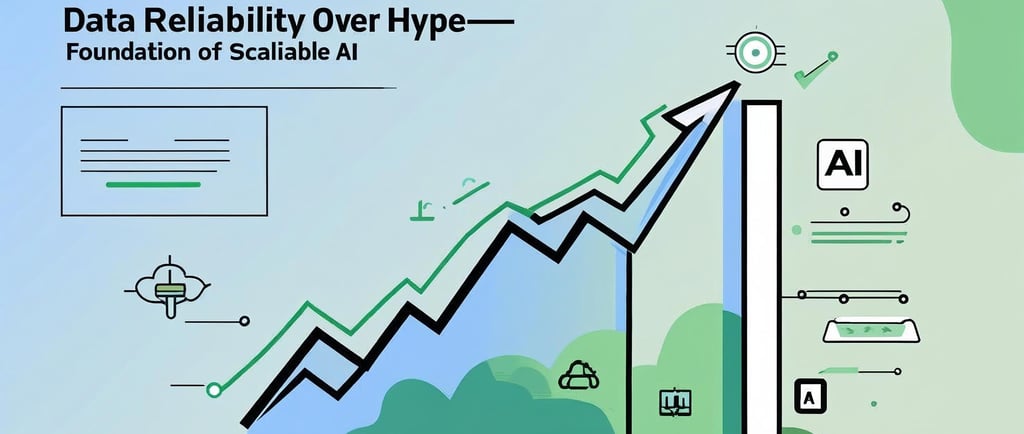Data Reliability Over Hype: The Foundation of Scalable AI
AI can’t fix what your data breaks. In the race to adopt AI, many organizations overlook the most critical success factor: trusted, high-quality data. This blog explores why data reliability—not just tools or models—is the foundation of scalable, trustworthy AI. It highlights the dangers of skipping governance, the cost of silos, and the risk of eroded trust. You’ll discover how AI-first organizations treat data as a strategic asset, invest in shared platforms, and empower cross-functional data stewardship. Because in a world of predictive models and machine intelligence, bad data doesn’t just break AI—it breaks belief.
AI FIRST MINDSET
Nivarti Jayaram
7/24/20253 min read


"AI can’t fix what your data breaks"
You Can’t Automate Insight From Chaos
You’ve got the latest AI platform.
You’ve built a slick dashboard.
You even piloted a model that seemed promising—until it wasn’t.
The problem? It wasn’t the AI. It was the data.
Unstructured. Incomplete. Siloed.
And once your teams realize the output is off, the damage is done:
Trust disappears. Adoption stalls. ROI evaporates.
“AI built on messy, siloed data is like building a house on sand.”
Yet far too many organizations rush into AI asking: “Which model should we use?”
When the better question is: “Can we trust the data that powers it?”
The Problem with Data Hype
According to TechRadar, 89% of business leaders say they must unify and clean their data before they can see any real AI value. But instead of solving that, many companies get caught in the AI hype trap:
Spinning up proof-of-concept models with stale or biased data
Operating in silos where departments hoard their data
Skipping governance in the name of speed
Using AI to mask bad data instead of fixing the root cause
The result?
Models deliver misleading or irrelevant insights
Teams lose faith in the outputs
Stakeholders pull back from further investment
And here’s the kicker: Once trust in AI is lost, it’s nearly impossible to regain.
What AI-First Organizations Do Differently
Organizations that win with AI don’t start with algorithms. They start with accountability for the data that feeds them.
Here’s how they shift from hype to healthy AI.
1. Treat Data Quality as a Strategic Investment
Data quality isn’t a side quest.It’s the foundation.
AI-first organizations:
Assign ownership for key data assets
Set KPIs around accuracy, completeness, freshness, and lineage
Budget for proactive data cleansing, enrichment, and de-duplication
They treat “data debt” like tech debt: unacceptable.
Leadership in Action: “If you wouldn’t run your business on bad numbers, why would you train AI on them?”
2. Build Shared, Scalable Data Platforms
If every department has its own data stack, you don’t have agility. You have entropy. Instead of disconnected tools and data silos, AI-ready enterprises build:
Centralized data lakes, warehouses, or data meshes
Unified data models that serve both operations and analytics
Governed APIs and virtualization layers that ensure secure access
This allows AI to be used repeatedly and reliably—across use cases and departments.
Leadership in Action: Fund platforms, not pilots. Invest in interoperability, not just output.
3. Empower Cross-Functional Data Stewards
Clean data doesn’t come from tools alone—it comes from people who understand the data’s meaning and context.
AI-first organizations:
Create data product owners embedded in business functions
Build data governance councils that include legal, ops, tech, and finance
Assign data stewards for key domains who partner with AI teams
Leadership in Action: Your best data stewards are your process owners. Give them ownership—and the tools to fix what’s broken.
Why This Matters for AI Performance
Let’s be clear: AI doesn’t invent insight.It amplifies what’s already there in your data.
So if your data is:
Inaccurate
Biased
Incomplete
Stale
Poorly governed
Then your AI will be too. That means
Biased recommendations
Poor decision-making
Legal and compliance risk
User frustration and disengagement
A flawed insight delivered faster is still a flawed decision.
Leadership Takeaway: Trust Is the Real Accelerator
Before you ask: “What’s our AI strategy?”
Ask:
“How trustworthy is the data it will learn from?”
“Who owns that data, and how clean is it?”
“Are our business users confident in the outputs today?”
Start here:
Fund data reliability as part of every AI project
Make data governance a team sport—cross-functional, collaborative, and visible
Build infrastructure that prioritizes shared access, context, and control
Because in an AI-first world, bad data doesn’t just cost time—
it erodes trust, derails value, and damages your credibility.
Final Word: AI Can’t Save You From Dirty Data
You can have the most advanced AI tools in the world. But if your data is flawed, your insights will be too.
Think of AI like an engine. Data is the fuel. Bad fuel ruins great engines.
Don’t just build AI. Build the conditions where AI can thrive—on top of data that’s clean, connected, and complete.
That’s not hype. That’s what real scalability looks like.
In summary
Data is not just a technical layer—it’s a leadership priority
Don’t ask “What model should we build?” until you ask “Is our data reliable?”
In AI, trust is a prerequisite, not a byproduct
